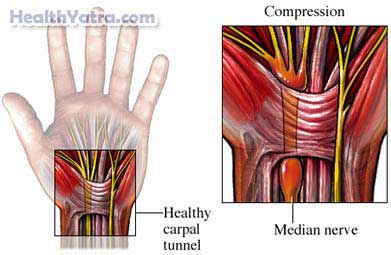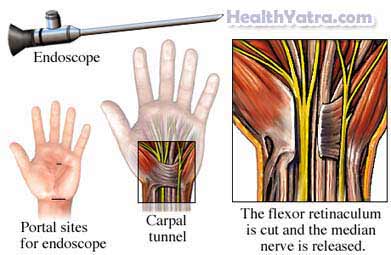Definition
Carpel tunnel release is a surgery where the ligament covering the carpel tunnel is cut open.

Reasons for Procedure
The median nerve runs from the forearm into the hand. Carpal tunnel syndromeoccurs when this nerve is squeezed at the wrist as it runs through the carpel tunnel. This results in pain, weakness, tingling, or numbness in your hand and wrist. Pain may also radiate up your arm.
Carpal tunnel release is a surgery to relieve pressure on the median nerve. The pressure is reduced by opening the ligament of the carpal tunnel. The ligament is called the transverse carpal ligament.
Surgery to treat carpal tunnel syndrome is usually recommended in the following instances:
- Other therapies have failed, including icing, splints or braces, anti-inflammatory medicines, steroid injections, physical therapy, or ultrasound.
- There is shrinkage (atrophy) and weakness of the muscles controlling the thumb.
- Studies of nerve functioning show the median nerve is not working properly.
Possible Complications
Complications are rare, but no procedure is completely free of risk. If you are planning to have carpal tunnel release, your doctor will review a list of possible complications, which may include:
- Infection
- Bleeding
- Swelling
- Nerve damage
- Stiffness of the fingers
- Continued numbness, tingling, weakness, or pain
Factors that may increase the risk of complications include:
- Smoking or alcohol abuse
- Diabetes
- Taking steroid medicine for other conditions
What to Expect
Prior to Procedure
Your doctor may do the following:
- Physical exam (concentrating on strength and sensation in the hands)
- Blood tests
- Nerve conduction studies —measuring the nerves’ ability to send impulses to the muscles of the thumb
- Electromyogram (EMG) —a recording of the electrical activity in muscles
- MRI scan —a test that uses magnetic waves to make pictures of structures inside the body
Leading up to your procedure:
- Talk to your doctor about your medicines. You may be asked to stop taking some medicines up to one week before the procedure, like:
- Aspirin or other anti-inflammatory drugs
- Blood thinners, such as clopidogrel (Plavix) or warfarin (Coumadin)
- Arrange for a ride to and from the procedure.
- Arrange for help at home after the procedure.
- The night before, eat a light meal. Do not eat or drink anything after midnight.
- You may be asked to shower the morning of your procedure.
Anesthesia
General anesthesia or local anesthesia with sedation is used. If you have general anesthesia, you will be asleep during the procedure. With local anesthesia, the area being operated on will be numbed, and you may be given a sedation medicine to help you relax.
Your doctor will discuss with you which may be best.
Description of the Procedure
A classic open incision or an endoscopic technique may be used:
Open Carpal Tunnel Release
A short incision will be made in the lower palm and wrist area. The carpal ligament will be opened. This will free the median nerve. The incision will then be closed with stitches. A bulky bandage will be applied to the wound.
Endoscopic Carpal Tunnel Release
Two tiny cuts in the skin will be made on the palm side of the wrist. A small tool with a camera will be passed through an incision. This camera will allow the doctor to see inside of the carpal tunnel. Other surgical tools will be passed through the other incision. The doctor will use these tools to release the carpal ligament. After the camera and instruments are removed, a few stitches will be needed to close the incisions. A bulky bandage will then be placed over the wounds.
In some cases, the doctor may need to change to the open procedure.

How Long Will It Take?
About 15-60 minutes
How Much Will It Hurt?
Anesthesia will prevent pain during the procedure. Once the anesthesia wears off, you will have some pain in the area. Talk to your doctor about medicine to help manage the pain.
Post-procedure Care
At the Care Center
You will be monitored in a recovery area until you are ready to go home. Your hand and wrist will be wrapped in a bulky bandage. The wrist will be elevated to control swelling. Ice packs may be applied periodically.
At Home
When you return home, do the following to help ensure a smooth recovery:
- Keep your hand elevated as much as possible for several days. This will help to decrease swelling and pain.
- Apply an ice pack to your wrist and hand for 20 minutes at a time, every 3-4 hours, for the first few days after your procedure.
- If your bandage becomes soiled, your doctor may advise you to change it or may ask you to see him or her.
- Ask your doctor about when it is safe to shower, bathe, or soak in water.
- Do not lift heavy things or strain the hand and arm until you are advised that you may do so by your doctor.
- Return to your doctor in 7-10 days to have the stitches removed.
- Follow the exercise program recommended by your doctor once you have begun to heal. You may be asked to go to physical therapy.
- Arrange to have help around the house, especially if you have had both hands operated on.
- Many cases of carpal tunnel syndrome are believed to occur due to repetitive actions (often related to work). Check with your doctor about how to prevent a recurrence.
- Be sure to follow your doctor’s instructions .
You may have to wear a brace or splint for several weeks after surgery. Complete recovery may take four weeks or longer. The pain and numbness or tingling in your hand and fingers usually improves rather quickly. Your grasp strength will slowly begin to improve.
Call Your Doctor
After arriving home, contact your doctor if any of the following occurs:
- Signs of infection, including fever and chills
- Redness, swelling, increasing pain, excessive bleeding, or any discharge from the incision site
- Nausea and/or vomiting that you cannot control with the medicines you were given after surgery, or which persist for more than two days after discharge from the hospital
- Pain that you cannot control with the medicines you have been given
- Increased tingling or weakness in your hand
- Fingers become extremely swollen, cool, or discolored
- Cough, shortness of breath, or chest pain
In case of an emergency, call for medical help right away.
